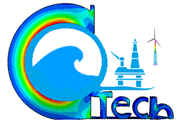Speaker
Description
This study investigates optimizing the front wall geometry of an Oscillating Water Column (OWC) chamber to enhance turbine performance and output efficiency when harnessing progressive waves with consistent periods and wavelengths. Numerical Wave Tank (NWT) adopted simulations carried out using ANSYS-Fluent package, VOF method with multiphase flow (air-water) where 2-D wave motion of NWT implemented using a C+ computer code. The frontal wall angle of the air/water chamber changed from 0° to 80°, for 10 cases. OWC system was most effective in harnessing and converting wave energy at 0° angle, reaching the maximum power output of 605.08W/m. In contrast, 80° angle exhibited lower efficiency, with the lowest power output of 26.55W/m. The average power output over time reflects consistent energy conversion, with the 0° angle demonstrating the highest average power output of 123.72W/m, while the 80° case exhibited less efficient pneumatic power potential with an average of 3.5W/m. A uniform cross-section provides higher pneumatic power when with PTO in OWC. The efficiency of power generation can be increased by approximately 10 to 20% while keeping 0 to 10-degree angle of the front wall without any appendages fitted into the wall.
| Conference Topic Areas | Track2: Advanced Computational Methods and Applications in Marine, Subsea and Offshore Technology |
|---|

